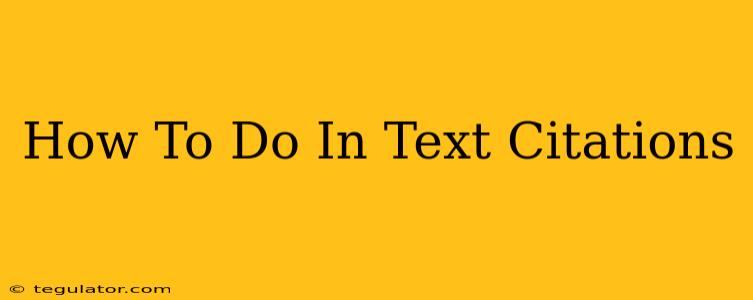In-text citations are crucial for academic writing. They give credit to your sources and avoid plagiarism. This guide provides a comprehensive look at how to correctly format in-text citations, covering different citation styles and offering helpful tips to avoid common mistakes. Mastering in-text citations is key to producing credible and ethical academic work.
Understanding In-Text Citations
In-text citations, also known as parenthetical citations, are brief references within your text that correspond to a full citation in your bibliography or works cited page. They provide the reader with immediate context about the source of the information you're presenting. This allows your reader to easily locate the full citation details for further investigation.
Why are In-Text Citations Important?
- Avoiding Plagiarism: Properly citing your sources is essential to avoid plagiarism, a serious academic offense. It shows you've done your research and aren't presenting someone else's work as your own.
- Supporting Your Arguments: Citations add weight to your claims by showing evidence from credible sources. They bolster your arguments and increase the credibility of your work.
- Enabling Verification: Readers can verify the accuracy of your information by referencing the sources you cite. This transparency builds trust and strengthens your academic standing.
- Demonstrating Research: Effective citation demonstrates the breadth and depth of your research. It showcases your ability to find and utilize relevant sources to support your ideas.
Common Citation Styles and Their Formats
Different academic disciplines often utilize specific citation styles. Here are a few of the most common, showing how in-text citations are formatted:
MLA (Modern Language Association)
MLA style typically uses the author's last name and page number in parentheses.
- Example: (Smith 123). This means the information came from page 123 of a work by an author named Smith.
- Multiple Authors: For two authors, list both last names (Smith and Jones 123). For three or more, use the first author's last name followed by "et al." (Smith et al. 123).
- No Author: If there is no author, use the title (or a shortened version) in place of the author's name ("Title" 123).
- Direct Quote: When directly quoting, include the page number along with the quote (Smith 123).
APA (American Psychological Association)
APA style also commonly uses the author's last name and year of publication. Page numbers are included for direct quotes.
- Example: (Smith, 2023). This indicates the information came from a work by Smith published in 2023.
- Direct Quote: (Smith, 2023, p. 123). This shows a direct quote from page 123 of Smith's 2023 work.
- Multiple Authors: Similar to MLA, use all authors' last names for two authors (Smith & Jones, 2023), and et al. for three or more (Smith et al., 2023).
Chicago/Turabian
Chicago/Turabian style offers two main systems: notes and bibliography and author-date. The author-date system is similar to APA, using author and date in parentheses. The notes and bibliography system uses footnotes or endnotes for citations.
Tips for Accurate In-Text Citations
- Consistency is Key: Maintain consistency throughout your paper with the chosen citation style.
- Accuracy is Paramount: Double-check all information (author names, dates, page numbers).
- Use a Citation Management Tool: Tools like Zotero, Mendeley, or EndNote can significantly simplify the citation process.
- Consult a Style Guide: Refer to a comprehensive style guide for your chosen citation style to address specific scenarios.
- When in Doubt, Cite: If you're unsure whether to cite something, it's always better to err on the side of caution and cite it.
Mastering In-Text Citations: A Path to Academic Success
Successfully implementing in-text citations demonstrates academic integrity and strengthens your research. By carefully following the guidelines and utilizing available resources, you can master this essential skill and improve the quality and credibility of your work. Remember, proper citation isn't just about avoiding plagiarism; it's about contributing to the broader academic conversation in a responsible and ethical manner.

